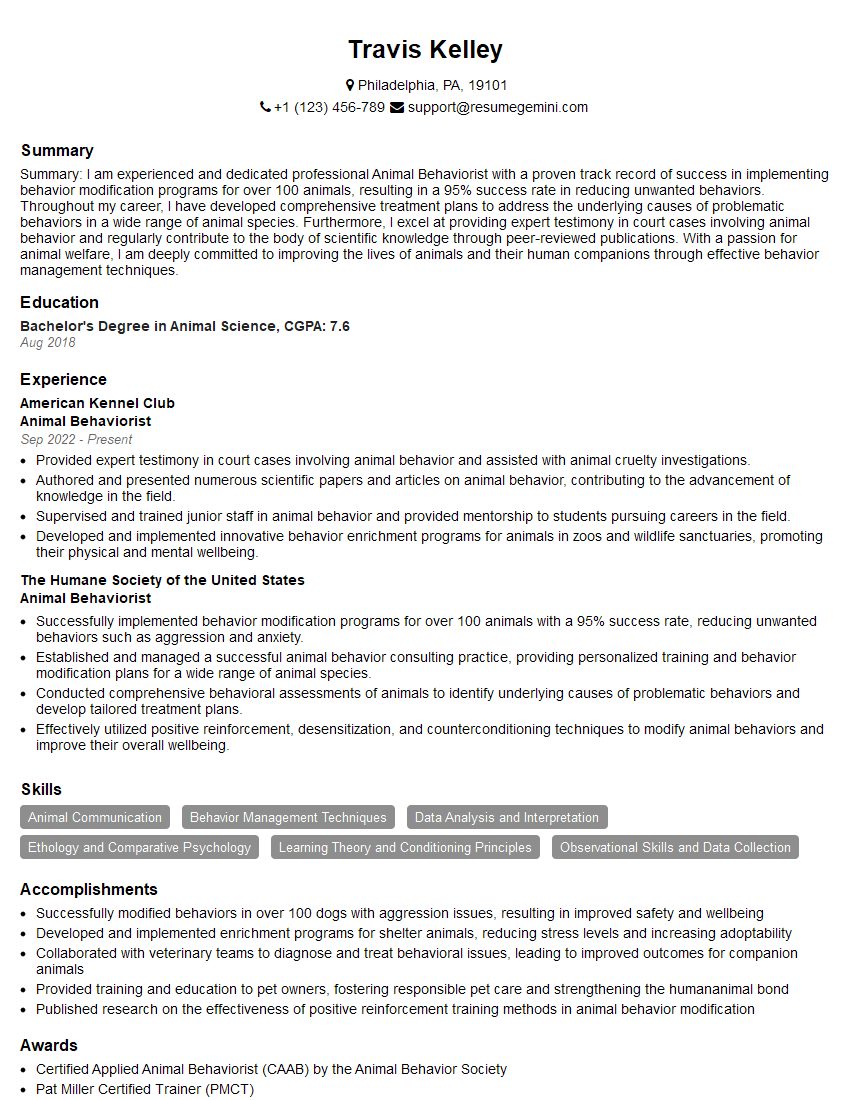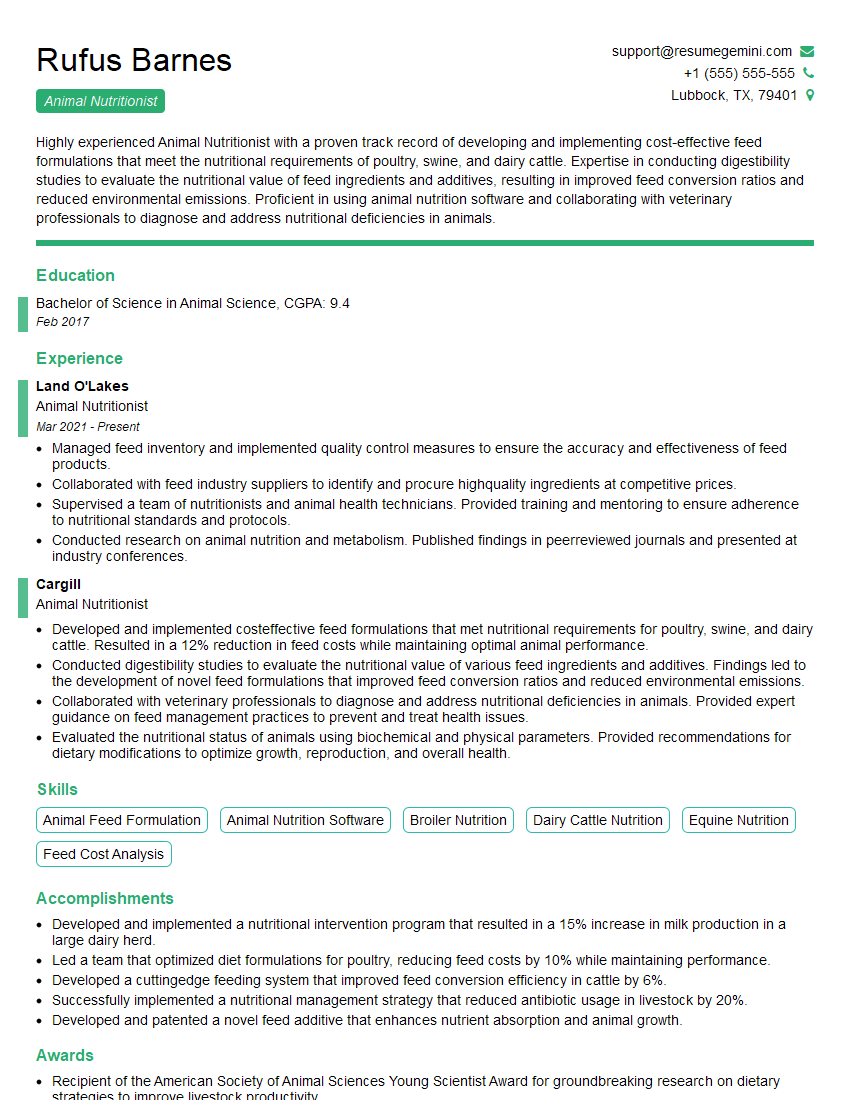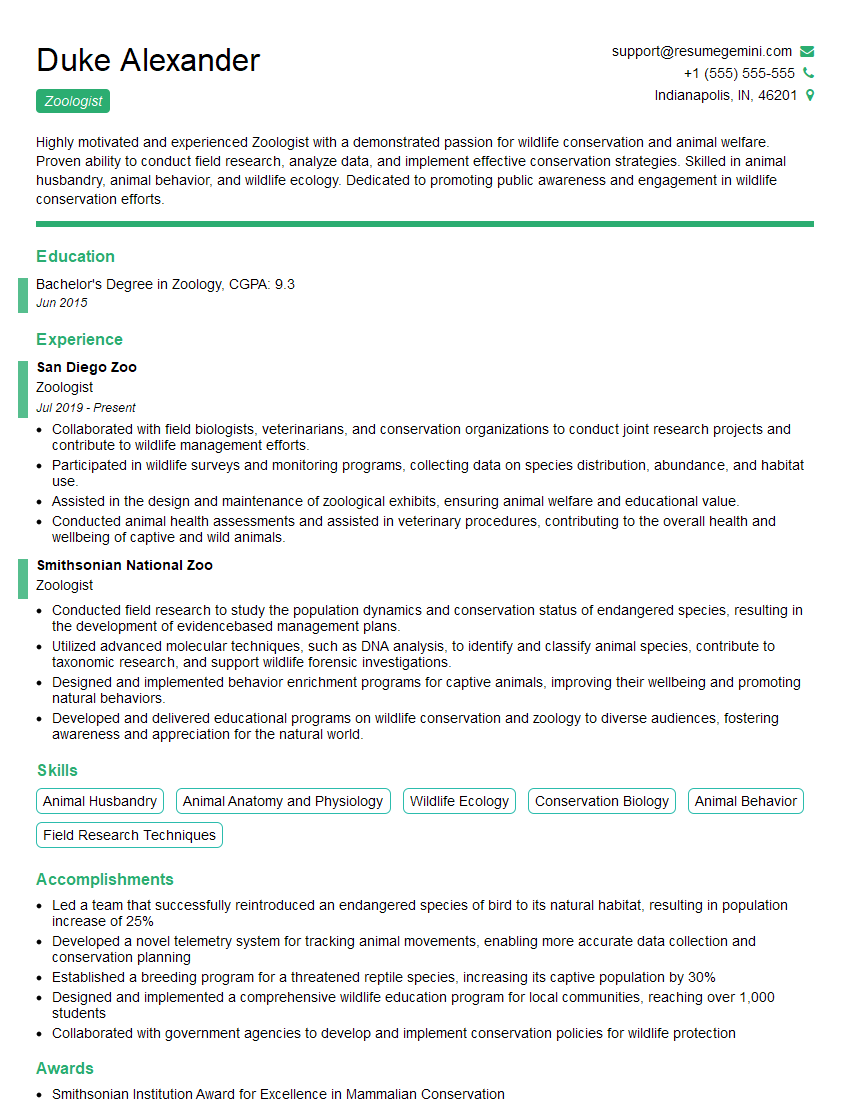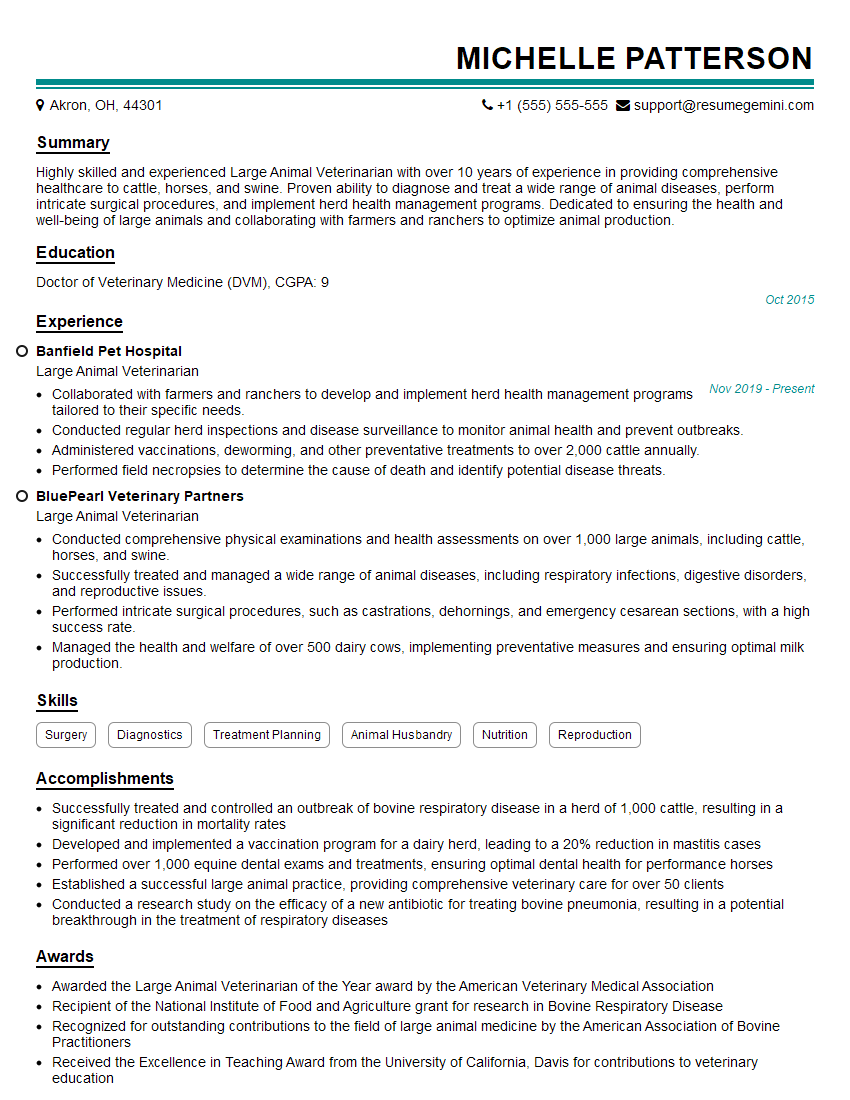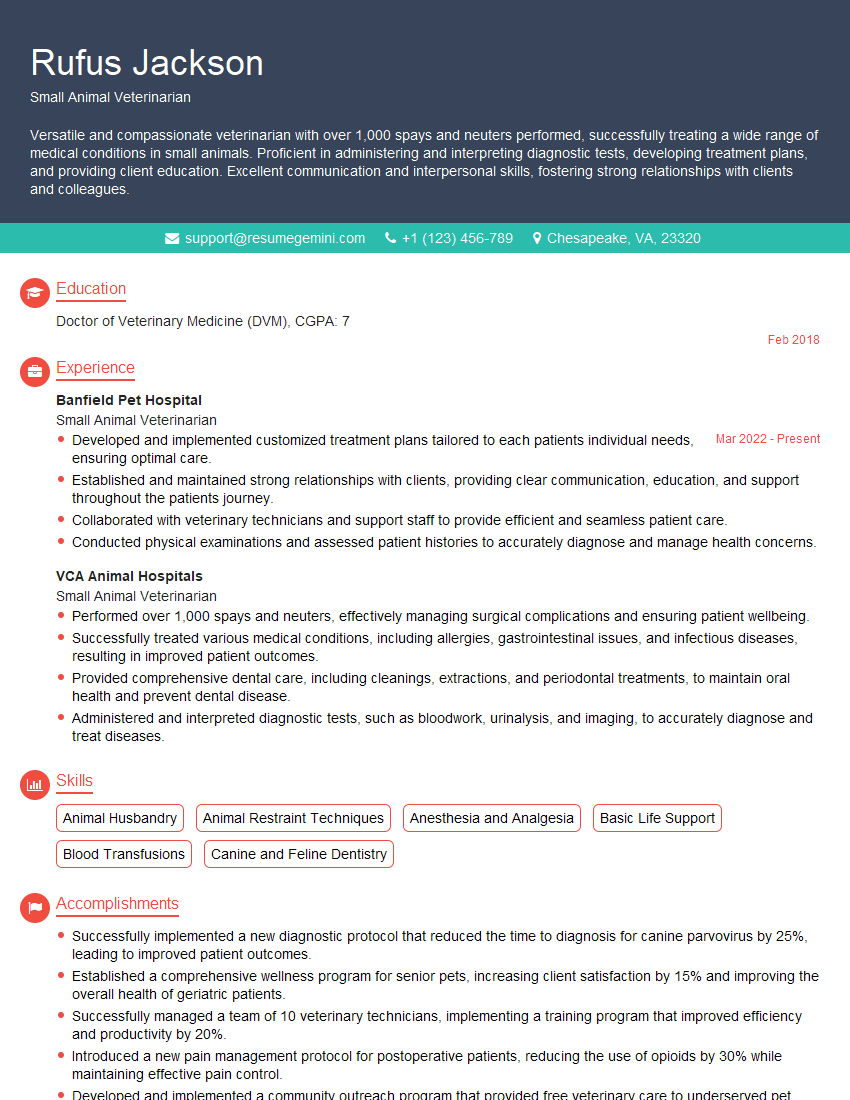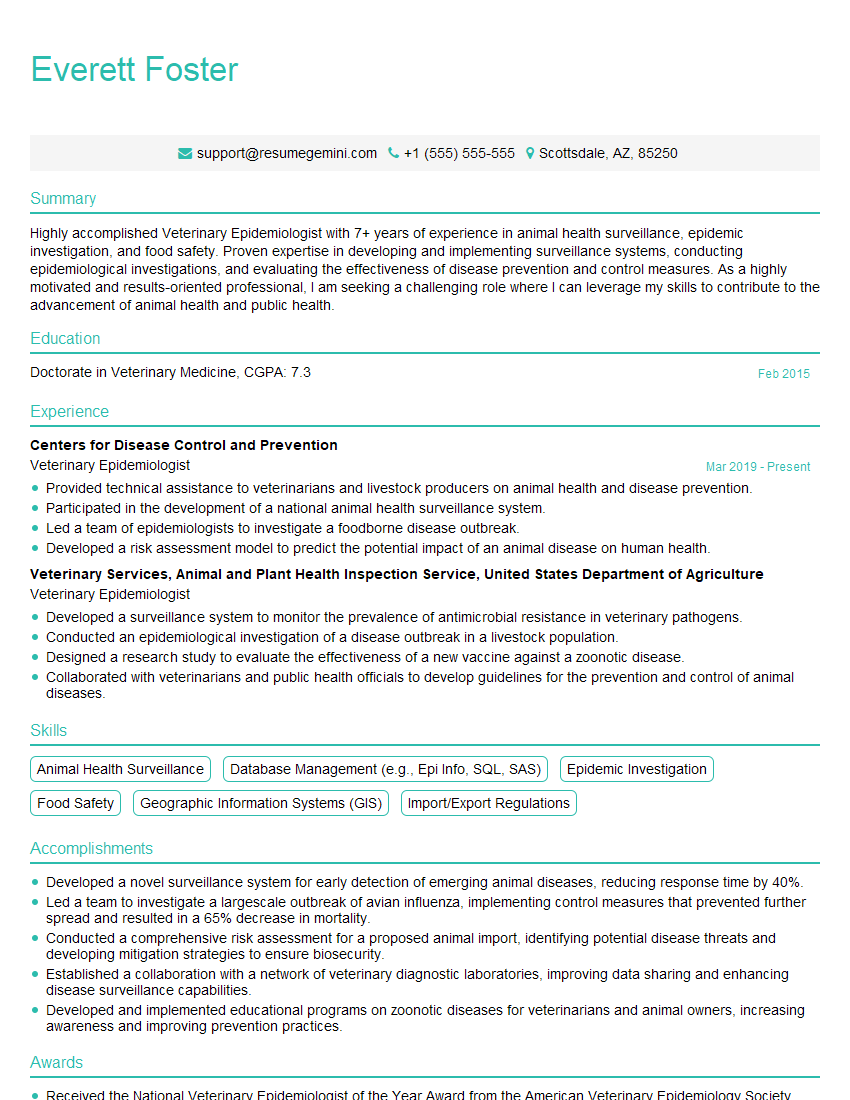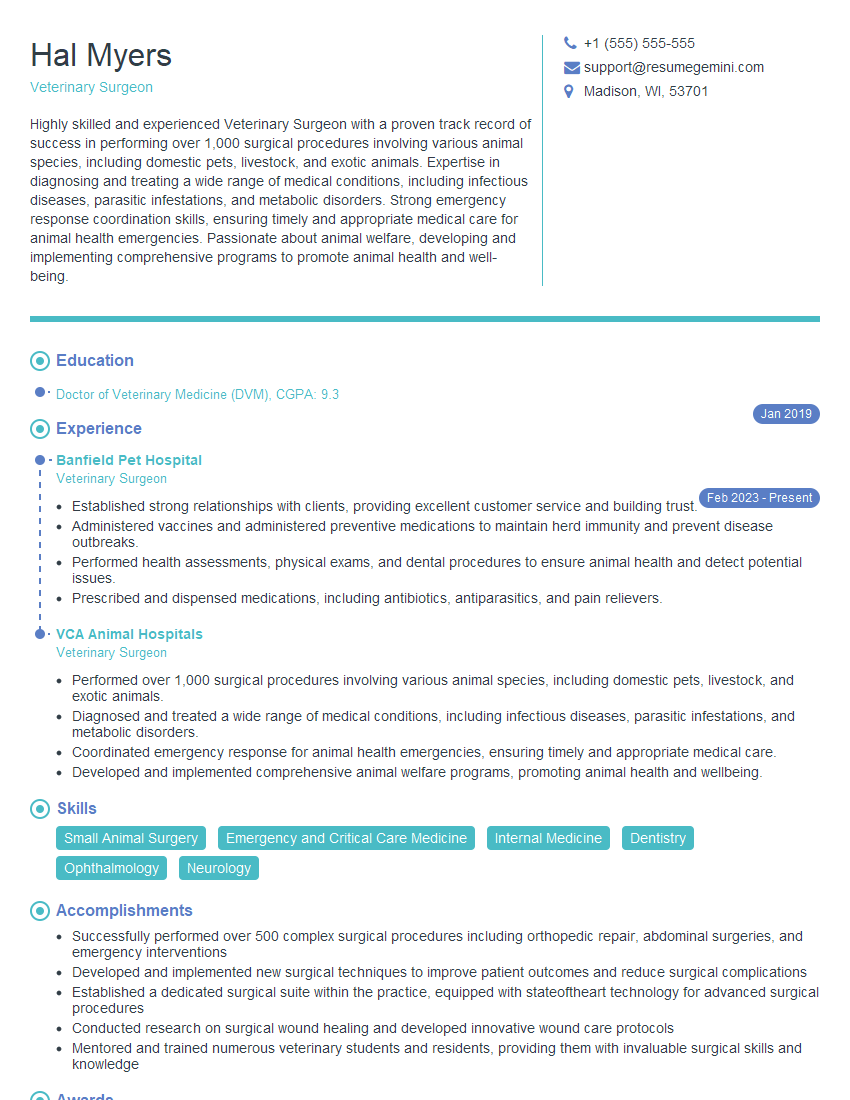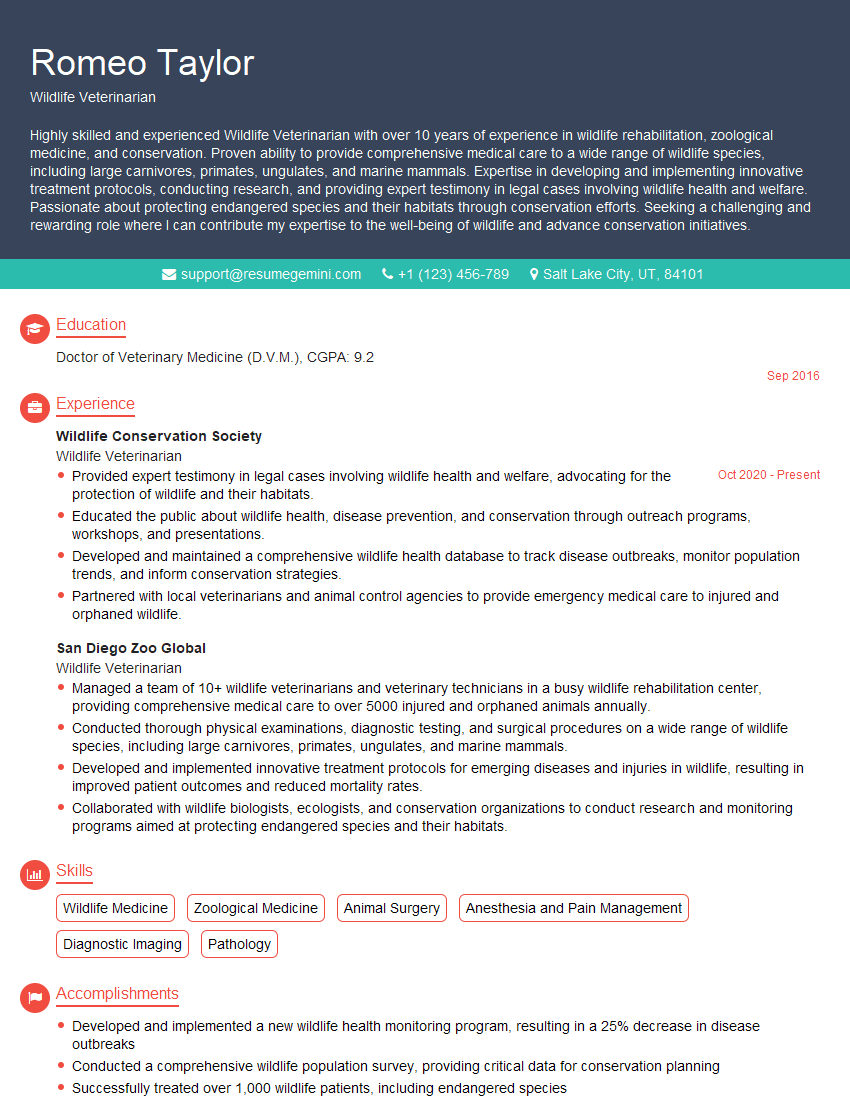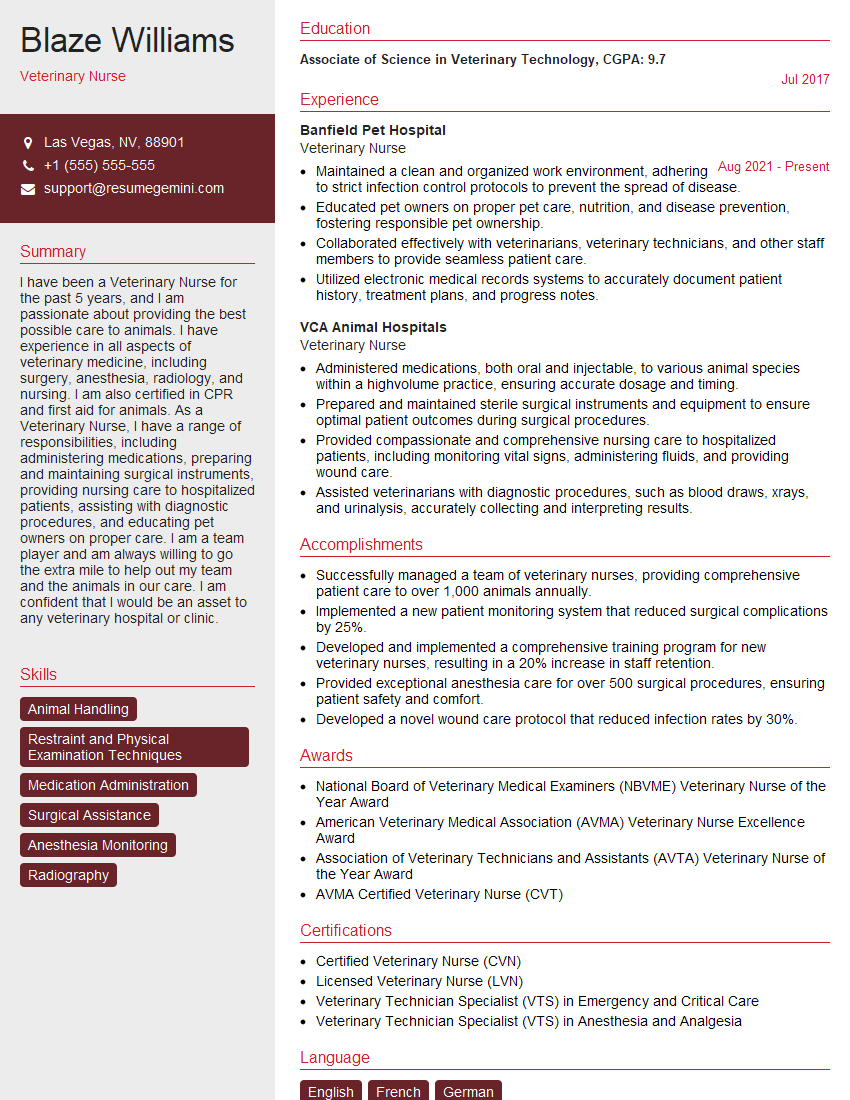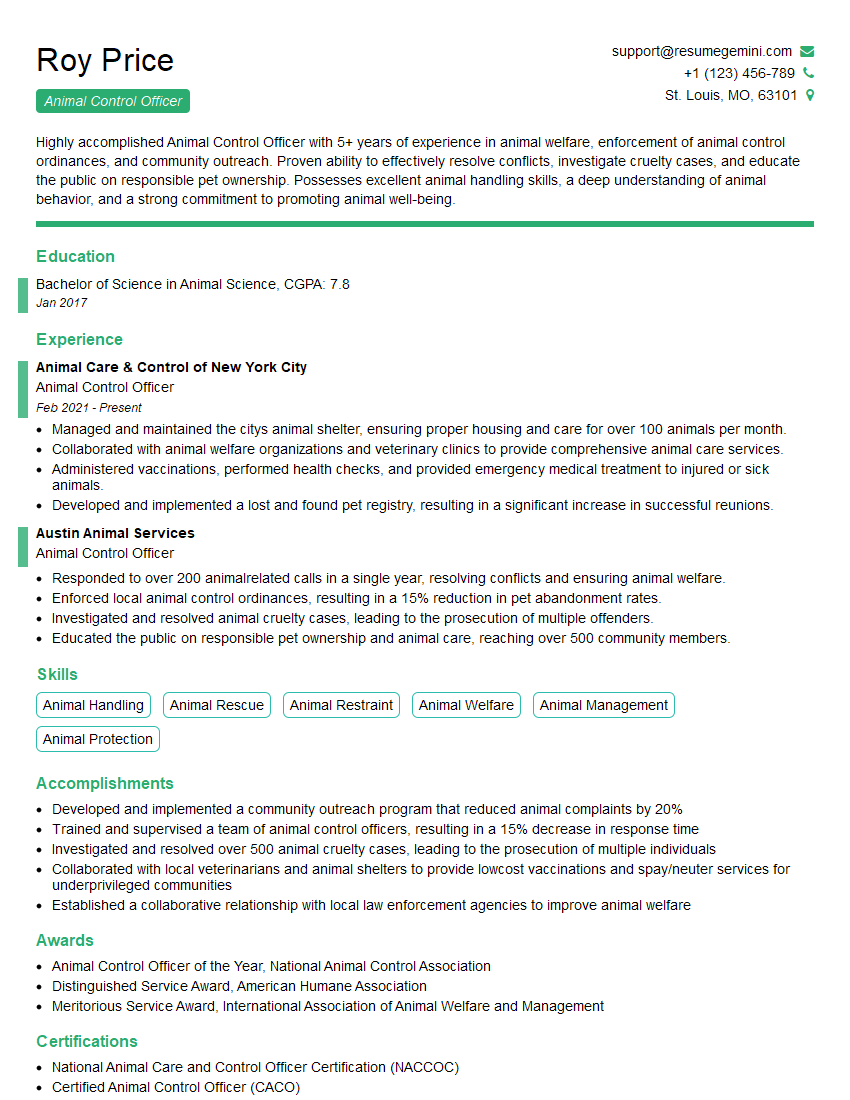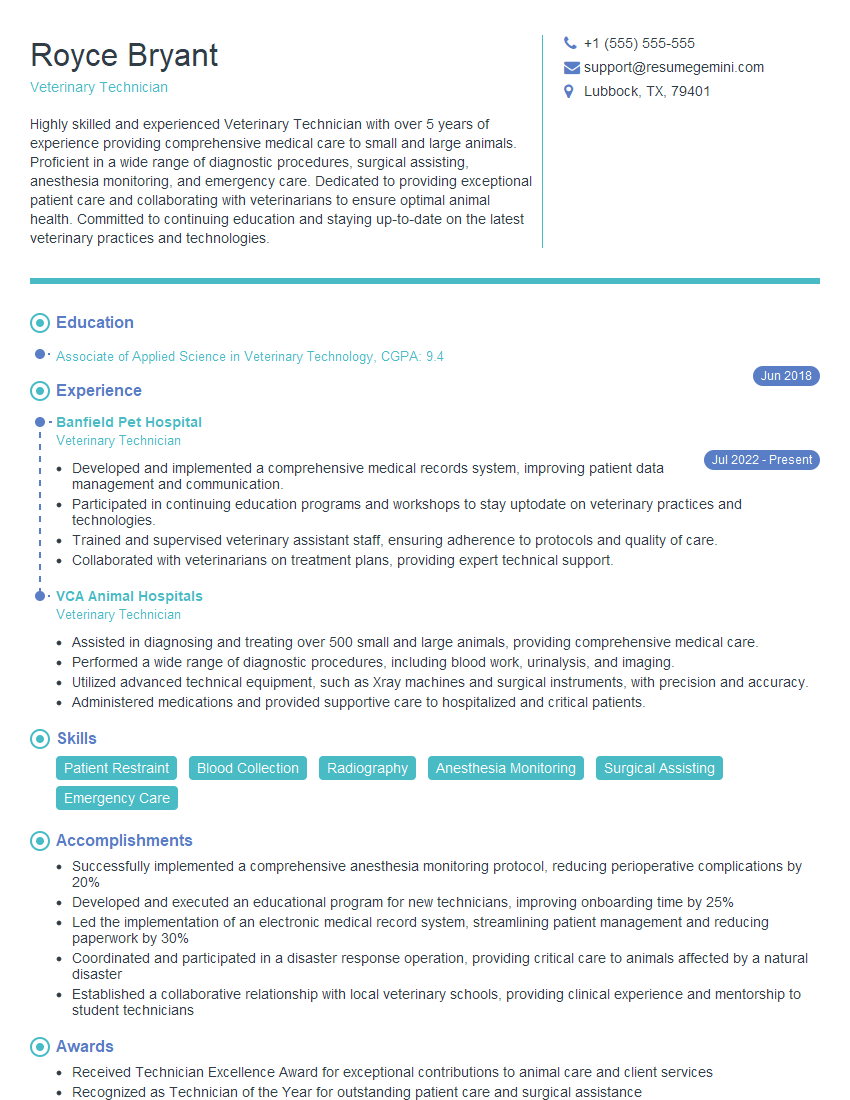Cracking a skill-specific interview, like one for Commitment to animal health and well-being, requires understanding the nuances of the role. In this blog, we present the questions you’re most likely to encounter, along with insights into how to answer them effectively. Let’s ensure you’re ready to make a strong impression.
Questions Asked in Commitment to animal health and well-being Interview
Q 1. Describe your experience in administering vaccinations.
Administering vaccinations is a crucial aspect of preventative animal healthcare. My experience encompasses a wide range of species, from small companion animals like cats and dogs to larger livestock such as cattle and horses. I’m proficient in selecting the appropriate vaccine based on the animal’s age, species, health status, and the prevalent diseases in the region. This involves understanding vaccine schedules, proper storage and handling to maintain efficacy, and recognizing contraindications. The process itself requires careful preparation – ensuring the animal is properly restrained (without causing undue stress), selecting the correct injection site based on anatomical considerations, and employing aseptic technique to prevent infection. Post-vaccination monitoring is critical, watching for any adverse reactions such as swelling, fever, or lethargy. For example, vaccinating a kitten against feline panleukopenia requires a different approach than vaccinating a mature horse against influenza, necessitating careful adaptation of technique and handling to the specific animal.
I’ve also gained experience in managing vaccination programs for large populations, such as herd vaccination programs in cattle ranches, which involves logistical planning, record-keeping, and efficient team coordination. Accurate record keeping, ensuring traceability and allowing for future health assessments, is key. Proper documentation and the identification of each animal is crucial for disease surveillance and monitoring vaccination coverage.
Q 2. Explain your understanding of animal pain management techniques.
Animal pain management is multifaceted and relies on a holistic approach considering the animal’s species, age, and the nature of the pain. My understanding encompasses pharmacological and non-pharmacological methods. Pharmacological methods involve administering analgesics (pain relievers), anti-inflammatories (to reduce swelling), and anesthetics (for more severe pain or procedures). The choice of analgesic depends heavily on the type and intensity of the pain. For example, a simple ear infection might be managed with a mild NSAID (non-steroidal anti-inflammatory drug), while post-surgical pain would require a stronger opioid analgesic. Dosage and administration route (oral, injectable, topical) are meticulously calculated based on the animal’s weight and species.
Non-pharmacological methods are equally vital and include environmental enrichment, providing a comfortable and safe environment to reduce stress, which indirectly manages pain perception. This might involve providing soft bedding, minimizing noise and bright lights, and offering distractions such as toys or gentle petting. Physiotherapy techniques, like hydrotherapy or massage, can also help alleviate pain and promote healing. Regular assessment of the animal’s pain levels using a validated pain scale is vital, allowing us to adjust the pain management plan accordingly. I’ve used the Glasgow Composite Pain Scale for cattle and the UNESP-Botucatu Pain Scale for dogs in my experience, constantly adapting the approach according to individual patient response.
Q 3. What are the common signs of animal distress?
Recognizing signs of distress in animals is crucial for providing timely and appropriate care. Common indicators vary across species but can include changes in behavior, posture, and physiological parameters. Behavioral changes might involve hiding, reduced activity, vocalization (whining, crying, or unusual vocalizations), aggression or excessive fear, changes in appetite (anorexia or increased hunger), and changes in sleep patterns (restlessness or excessive sleepiness).
Postural changes can include hunched posture, reluctance to move, unusual gait, or difficulty standing. Physiological signs include elevated heart rate, increased respiratory rate, pale gums, elevated temperature, diarrhea or constipation, and changes in urination frequency or volume. For example, a cat exhibiting flattened ears, dilated pupils, and a tucked tail is showing clear signs of fear or stress. A dog with labored breathing, rapid pulse, and pale gums may indicate internal bleeding or shock. It’s critical to understand the animal’s baseline behavior, making it easier to identify deviations signifying distress.
Q 4. How would you handle a situation involving an aggressive animal?
Handling an aggressive animal requires a calm, careful, and controlled approach, prioritizing both animal and human safety. Never approach an aggressive animal directly; instead, assess the situation from a safe distance. Understanding the potential cause of the aggression is important – it could be fear, pain, territoriality, or protective instincts. My approach involves creating a safe distance, using visual barriers if possible, and avoiding direct eye contact, which can be perceived as a threat. I would never try to restrain a seriously aggressive animal alone. If possible, I would seek assistance from trained handlers or animal control professionals with the appropriate tools and experience, such as catch poles and protective gear.
Depending on the animal and situation, I might use a combination of positive reinforcement techniques to try to calm the animal (e.g. offering food from a distance, a gentle and calm voice), whilst simultaneously ensuring my safety and creating the conditions necessary for professionals to handle the situation safely and effectively. Sedation might be necessary in extreme cases, but this should always be a last resort under appropriate veterinary guidance to avoid the risk of exacerbating the aggression.
Q 5. Describe your experience with diagnosing and treating common animal illnesses.
My experience in diagnosing and treating common animal illnesses is extensive, encompassing a broad spectrum of conditions. This begins with a thorough history taking, including details about the animal’s symptoms, diet, vaccination history, and environmental factors. A comprehensive physical examination follows, involving careful palpation, auscultation (listening to heart and lungs), and observation of vital signs (temperature, pulse, respiration). Depending on the suspected illness, further diagnostic tests such as blood work, urinalysis, radiographs (X-rays), ultrasound, or biopsies may be necessary. For example, a dog presenting with vomiting and diarrhea might require blood tests to check for dehydration and electrolyte imbalances, fecal examination to identify parasites, or abdominal X-rays to rule out intestinal obstructions.
Treatment plans are tailored to individual needs, incorporating medication, supportive care, and nutritional adjustments. For example, a cat with a urinary tract infection would receive antibiotics, increased water intake, and potentially a change in diet. Monitoring the animal’s response to treatment is crucial, allowing for timely adjustments to ensure optimal outcomes. Maintaining clear and thorough record keeping during diagnosis and treatment is important for effective animal care, tracking patient progress, and providing information for other practitioners if needed. Continuous professional development, keeping abreast of current best practices and advancements in veterinary medicine, is also critical in managing such cases.
Q 6. How do you ensure the proper sanitation and hygiene in an animal care setting?
Maintaining proper sanitation and hygiene is paramount in any animal care setting, preventing the spread of infectious diseases. This involves a multi-pronged approach incorporating regular cleaning and disinfection protocols. All surfaces (cages, floors, equipment) should be cleaned daily using appropriate disinfectants effective against a wide range of bacteria and viruses. Specific protocols must be followed, such as the proper dilution and contact time of disinfectants to ensure efficacy. All waste (feces, urine, food scraps) must be removed promptly and disposed of properly, and all bedding needs regular changing, to control parasite spread. Hand hygiene is equally critical; staff should wash their hands frequently with soap and water, or use alcohol-based hand rubs, especially before and after handling animals or cleaning.
In addition to routine cleaning, regular pest control is vital to prevent infestations, and vermin control will help minimize disease transmission risk and maintain a hygienic environment. Strict protocols should be in place for handling and disposal of potentially contaminated materials, including medical waste, to reduce transmission risk. Furthermore, a comprehensive understanding of infection control principles, including understanding different biosecurity measures, is essential. This also involves adhering to all relevant health and safety regulations and protocols to guarantee the well-being of both the animals and staff.
Q 7. Explain your knowledge of animal anatomy and physiology.
A strong understanding of animal anatomy and physiology is fundamental to my practice. This involves a detailed knowledge of the skeletal, muscular, nervous, circulatory, respiratory, digestive, and urinary systems in various animal species. Knowing the location and function of major organs and tissues is essential for conducting physical examinations, interpreting diagnostic tests, and making informed treatment decisions. For example, understanding the respiratory system’s structure allows me to assess the respiratory rate and auscultate for abnormal lung sounds, aiding in diagnosing respiratory infections. Similarly, knowledge of the circulatory system is vital for interpreting electrocardiograms (ECGs) and understanding cardiac conditions.
My understanding extends to species-specific variations in anatomy and physiology. A dog’s anatomy is significantly different from that of a bird, requiring specialized knowledge for proper diagnosis and care for each species. Understanding the physiological responses to stress, disease, and treatments is also crucial. For instance, recognizing the physiological changes associated with shock is critical in initiating appropriate emergency treatment, allowing the appropriate response in various situations. Continuous learning and staying updated on the latest research and advancements in veterinary medicine are essential for maintaining a high level of expertise in this area.
Q 8. Describe your experience with surgical assisting or post-operative care.
My experience in surgical assisting and post-operative care spans several years, encompassing a wide range of procedures from routine spays and neuters to more complex orthopedic surgeries. I’m proficient in preparing surgical sites, assisting the veterinarian with instrument and tissue handling, maintaining sterile conditions, and monitoring vital signs during the procedure. Post-operatively, my focus shifts to pain management, monitoring recovery, administering medications as prescribed, and ensuring the animal’s comfort and safe transition back to normal activity. For example, I’ve assisted in numerous feline orthopedic surgeries, learning to carefully monitor their post-operative pain levels and adjust analgesia accordingly to minimize discomfort and promote a smooth healing process. I am adept at recognizing potential complications such as hemorrhage or infection and taking immediate appropriate action. My experience also includes meticulous wound care, including cleaning, bandaging, and assessing for signs of infection or complications.
Q 9. How do you approach a fearful or anxious animal?
Approaching a fearful or anxious animal requires patience, understanding, and a calm, non-threatening demeanor. I start by observing the animal’s body language to gauge its level of anxiety—is it hiding, showing its teeth, or exhibiting other signs of stress? This allows me to tailor my approach. A slow, gentle approach is key, avoiding direct eye contact which can be perceived as aggressive. I use a soft voice and gentle touch, allowing the animal to approach me at its own pace. Positive reinforcement with treats and praise is crucial in building trust. Desensitization and counter-conditioning techniques are extremely helpful; gradually exposing the animal to the stimuli causing fear (e.g., sounds, handling) while simultaneously providing positive reinforcement. For instance, with a dog fearful of nail trims, I might start by simply touching its paws, rewarding calmness with treats, slowly working up to handling the feet and ultimately the nail trimming process over multiple sessions. This gradual process builds confidence and helps the animal associate positive experiences with previously feared situations.
Q 10. Explain your understanding of animal nutrition and dietary needs.
Animal nutrition is a complex field. Understanding the specific dietary needs of different species, breeds, ages, and health conditions is paramount. A balanced diet provides the necessary proteins, carbohydrates, fats, vitamins, and minerals for optimal health, growth, and reproduction. Factors such as age, activity level, breed predispositions, and any underlying health problems (e.g., diabetes, kidney disease) significantly influence dietary requirements. For example, a growing puppy needs a diet higher in protein and calories than a senior dog. Similarly, a diabetic cat requires a diet lower in carbohydrates. I’m skilled at calculating nutritional requirements based on body weight, activity level, and individual health factors. I also understand the importance of high-quality ingredients and the risks associated with poor-quality commercial pet foods. I can help owners make informed decisions about appropriate food choices and address specific nutritional concerns. Knowing how to interpret feed labels and understanding the difference between complete and incomplete diets is also a critical part of ensuring optimal animal health through proper nutrition.
Q 11. What is your experience with animal restraint techniques?
Safe and effective animal restraint is crucial for both the animal’s and the handler’s safety. My experience encompasses a variety of techniques, tailored to the animal’s species, size, temperament, and the specific procedure required. These include gentle manual restraint, such as holding a cat securely while administering medication, to more specialized techniques such as using capture poles, nets, or other equipment. Proper restraint minimizes stress and prevents injury. I understand the importance of choosing the least stressful and most humane restraint method for each situation. For example, I’ve learned different approaches for restraining fractious cats versus calm dogs. For large dogs, I might use a leash and a gentle but firm hold; for small, easily stressed animals, a towel might offer better comfort. Knowing when and how to employ chemical restraint (tranquilizers or anesthetics) under veterinary supervision is also a skill I utilize when necessary to ensure the safety and well-being of the animal and the staff. Safety is always the number one priority.
Q 12. Describe your knowledge of common animal parasites and their treatment.
My understanding of common animal parasites encompasses internal parasites (e.g., roundworms, hookworms, heartworms, coccidia) and external parasites (e.g., fleas, ticks, mites). I know how to identify the signs and symptoms of infestations, perform diagnostic tests (such as fecal examinations for internal parasites), and administer appropriate treatments under veterinary guidance. For example, I’m proficient in administering preventative heartworm medication, identifying and treating flea infestations through topical treatments or oral medications, and recognizing the clinical signs of tick-borne diseases. I understand the life cycle of different parasites and the importance of preventative measures to minimize exposure. My understanding extends to the zoonotic potential of certain parasites—those transmittable from animals to humans—and the importance of taking appropriate precautions to protect both animal and human health. Education and prevention are key to managing parasite infestations effectively and limiting their impact on animal welfare.
Q 13. How do you maintain accurate and detailed animal health records?
Maintaining accurate and detailed animal health records is essential for effective animal care and legal compliance. I use a combination of electronic and paper-based systems to document all aspects of an animal’s health history, including vaccinations, treatments, diagnostic test results, and observations. I ensure all records are clearly labeled, dated, and signed, following established protocols for data entry and storage. For example, I’d record the details of a vaccination, including the date, type of vaccine administered, lot number, and the site of injection. Similarly, details of any illness, treatment plans, and the animal’s response to treatment are meticulously documented. This detailed record-keeping allows for continuity of care, assists in identifying trends and patterns of disease, and provides valuable information for future veterinary consultations. Data security and privacy are paramount, and I adhere to all relevant regulations to maintain the confidentiality of animal health information.
Q 14. How do you ensure compliance with animal welfare regulations?
Ensuring compliance with animal welfare regulations is a non-negotiable aspect of my professional practice. I am familiar with local, state, and federal laws concerning animal care and handling, including those related to housing, sanitation, nutrition, transportation, and euthanasia. I understand and actively participate in implementing policies and procedures that ensure all animals under my care are treated humanely and ethically. This involves adhering to strict hygiene protocols, maintaining appropriate environmental conditions, ensuring adequate access to food, water, and shelter, and following established pain management protocols. I am always up-to-date on any changes or updates to regulations and readily adapt my practices to ensure continuous compliance. Furthermore, I proactively participate in continuing education opportunities to enhance my knowledge of animal welfare and promote best practices. In essence, my commitment is to providing the best possible care within a legally compliant and ethical framework.
Q 15. Describe your experience working with diverse animal species.
My experience spans a wide range of animal species, from common domestic pets like cats and dogs to exotic animals such as birds of prey and reptiles. I’ve worked in veterinary clinics, animal shelters, and wildlife rehabilitation centers, giving me diverse hands-on experience with their unique needs. For example, while canine care often focuses on preventative measures and common ailments, avian care requires specialized knowledge of their respiratory systems and dietary requirements. Similarly, reptile care necessitates understanding their thermoregulatory needs and specific housing conditions. This broad exposure has equipped me with adaptable skills, allowing me to quickly assess and address the health concerns of various species, regardless of their individual differences.
- Domestic Animals: Extensive experience in diagnosing and treating common illnesses, administering vaccinations, and performing routine check-ups for dogs and cats.
- Exotic Animals: Specialized knowledge in handling and caring for reptiles, birds, and other exotic animals, including understanding their unique dietary and environmental needs.
- Wildlife Rehabilitation: Experience in rescuing, rehabilitating, and releasing injured or orphaned wildlife, often requiring specialized handling techniques and knowledge of species-specific behaviors.
Career Expert Tips:
- Ace those interviews! Prepare effectively by reviewing the Top 50 Most Common Interview Questions on ResumeGemini.
- Navigate your job search with confidence! Explore a wide range of Career Tips on ResumeGemini. Learn about common challenges and recommendations to overcome them.
- Craft the perfect resume! Master the Art of Resume Writing with ResumeGemini’s guide. Showcase your unique qualifications and achievements effectively.
- Don’t miss out on holiday savings! Build your dream resume with ResumeGemini’s ATS optimized templates.
Q 16. Explain your understanding of animal behavior modification techniques.
Animal behavior modification utilizes positive reinforcement techniques to shape desired behaviors and reduce undesirable ones. It’s crucial to understand the underlying causes of problematic behaviors, such as fear, anxiety, or lack of training. Instead of punishment, which can create fear and aggression, we focus on rewarding positive actions. For instance, a dog exhibiting excessive barking might be rewarded with treats and praise for quiet moments, gradually increasing the duration of quiet time required for a reward.
Techniques I utilize include:
- Positive Reinforcement: Rewarding desired behaviors with treats, praise, or toys.
- Counter-Conditioning: Gradually associating a feared stimulus with positive experiences.
- Desensitization: Slowly exposing the animal to a feared stimulus at a manageable intensity.
- Environmental Enrichment: Providing stimulating environments to reduce boredom and anxiety.
For example, I worked with a cat that was exhibiting excessive scratching on furniture. By providing scratching posts strategically placed throughout the house and rewarding the cat when it used the posts, we successfully redirected its scratching behavior and protected the furniture. Each case requires a tailored approach based on the animal’s individual personality, history, and environment.
Q 17. How would you handle a situation involving a biosecurity breach?
A biosecurity breach, such as an infectious disease outbreak, requires immediate and decisive action. My approach involves a structured response based on established protocols.
- Immediate Containment: Isolate the affected animal(s) to prevent further spread. This might involve quarantining individuals or entire sections of a facility.
- Disease Identification: Conduct thorough testing to identify the pathogen and its transmission route.
- Notification and Reporting: Notify relevant authorities and comply with reporting requirements to prevent wider contamination.
- Sanitation and Disinfection: Implement rigorous cleaning and disinfection protocols to eliminate the pathogen from the environment.
- Prophylactic Measures: Administer preventive treatments to animals at risk of exposure.
- Post-Breach Assessment: Conduct a thorough review of protocols and practices to identify any weaknesses and improve biosecurity measures in the future.
For example, during a suspected avian influenza outbreak at a poultry farm, I would immediately quarantine the affected birds, notify the appropriate agricultural authorities, and implement stringent disinfection measures to prevent the disease’s spread to healthy flocks. This includes strict control of access to the affected area, disposal of infected material, and careful monitoring of all birds for any clinical signs of illness.
Q 18. Describe your experience with emergency animal care.
My emergency animal care experience includes responding to trauma cases, managing critical illnesses, and stabilizing animals in distress before veterinary intervention. This has involved providing immediate first aid, such as wound management, administering fluids, and cardiopulmonary resuscitation (CPR).
I’ve worked in situations requiring immediate stabilization of animals suffering from:
- Trauma: Fractures, lacerations, and internal injuries, requiring quick assessment, stabilization, and transport to a veterinary facility.
- Respiratory Distress: Administering oxygen therapy and other supportive measures.
- Cardiovascular Collapse: Performing CPR and administering emergency medications.
- Seizures: Protecting the animal from injury and providing post-seizure care.
A memorable instance involved a dog hit by a car. I quickly assessed the injuries, controlled bleeding, splinted a broken leg, and administered fluids before transporting the dog to the nearest emergency veterinary clinic, increasing its chances of survival.
Q 19. How do you prioritize animal care tasks in a busy environment?
Prioritizing animal care tasks in a busy environment requires a systematic approach. I employ a triage system based on the urgency of each animal’s needs:
- Emergency Cases: Animals requiring immediate life-saving interventions (e.g., respiratory distress, severe bleeding) take precedence.
- Urgent Cases: Animals with conditions requiring prompt attention to prevent deterioration (e.g., severe pain, infection).
- Routine Care: Tasks like vaccinations, check-ups, and preventative treatments are scheduled accordingly.
I also utilize time management techniques such as task lists, scheduling software, and efficient workflow processes to maximize my productivity and ensure that all animals receive the necessary care in a timely manner. This might involve delegating tasks appropriately to other team members if applicable, while maintaining close oversight to ensure consistent quality of care.
Q 20. Explain your experience with animal euthanasia and end-of-life care.
Euthanasia is a sensitive and difficult aspect of animal care. I approach it with compassion, respect, and a commitment to minimizing the animal’s suffering. My experience includes administering euthanasia according to established veterinary protocols, ensuring a peaceful and humane end-of-life experience. This often involves discussing end-of-life options with owners, providing emotional support, and helping them make informed decisions in their pet’s best interest.
Post-euthanasia care involves providing respectful handling of the animal’s remains and helping the owners cope with grief and loss. I believe in providing support to both the animal and the owner throughout this challenging process. The focus is always on minimizing stress and ensuring a dignified farewell for the animal.
Q 21. How do you communicate effectively with animal owners about their pet’s health?
Effective communication with animal owners is paramount. I employ clear, concise language, avoiding veterinary jargon whenever possible. I ensure that owners understand their pet’s diagnosis, treatment plan, prognosis, and potential risks and benefits.
My communication strategy includes:
- Active Listening: Understanding their concerns and answering their questions thoroughly.
- Empathy: Showing compassion and understanding their emotional state.
- Visual Aids: Utilizing diagrams or images to explain complex concepts.
- Written Information: Providing handouts or summaries of the discussion to reinforce key points.
- Follow-up: Contacting owners after appointments to check on their pet’s progress and answer any further questions.
For example, when explaining a complex diagnosis, I would use simple terms and analogies to help the owner grasp the situation, showing them relevant images or diagrams to clarify medical concepts. I always encourage owners to ask questions and ensure that they leave the consultation feeling informed and supported.
Q 22. What is your approach to continuing education in animal health?
Continuing education is paramount in the dynamic field of animal health. My approach is multifaceted and proactive, encompassing several key strategies. Firstly, I actively seek out relevant professional development opportunities, such as conferences, workshops, and webinars presented by reputable organizations like the American Veterinary Medical Association (AVMA) and the World Organisation for Animal Health (WOAH). These events provide updates on the latest research, disease outbreaks, and best practices. Secondly, I engage in self-directed learning through peer-reviewed journals like the Journal of Veterinary Internal Medicine and Preventive Veterinary Medicine. I carefully select articles focusing on areas relevant to my current work and emerging trends. Thirdly, I maintain a professional network by attending local veterinary meetings and participating in online forums and discussion groups, facilitating knowledge sharing and learning from the experiences of other professionals. This combined strategy ensures I remain current with advancements in diagnostics, treatment protocols, and animal welfare standards.
Q 23. Describe your problem-solving skills in a high-pressure animal care setting.
In high-pressure animal care settings, effective problem-solving is crucial. My approach relies on a systematic process. Firstly, I prioritize a calm and focused assessment of the situation, gathering all necessary information about the animal’s condition, history, and environment. This includes vital signs, observations of symptoms, and any relevant background information from owners or colleagues. Secondly, I employ a structured decision-making process, considering potential diagnoses based on my knowledge and experience, and consulting resources like diagnostic manuals and senior colleagues when needed. For example, when faced with a critically injured animal, I rapidly assess its airway, breathing, and circulation (ABCs), initiating immediate life-saving measures before proceeding to a thorough examination. Thirdly, I prioritize clear and concise communication with the animal’s owner and the veterinary team, ensuring everyone is informed of the situation, the chosen treatment plan, and its prognosis. Finally, I rigorously document all actions, assessments, and outcomes, facilitating learning from past cases and ensuring accountability.
For instance, during a sudden outbreak of respiratory illness in a shelter, I swiftly implemented isolation protocols, initiated contact tracing, and collaborated with the veterinary team to determine the causative agent and administer appropriate treatment, minimizing further spread and ensuring the well-being of the affected animals.
Q 24. How would you handle conflict with a colleague regarding animal care practices?
Conflict resolution is a vital skill in any collaborative environment. When disagreements arise regarding animal care practices, I prioritize open and respectful communication. My initial approach involves a private conversation with the colleague, focusing on understanding their perspective and concerns. I listen actively, seeking to identify the root cause of the conflict, rather than focusing on assigning blame. For instance, a difference of opinion might arise concerning the best anesthetic protocol for a specific procedure. Instead of dismissing their perspective, I would explain my rationale, citing relevant research and guidelines, and explore alternative solutions together, aiming for a consensus that prioritizes the animal’s well-being. If a resolution cannot be reached directly, I involve a neutral third party, like a supervisor, to facilitate mediation, fostering a fair and collaborative process. Transparency, mutual respect, and a shared commitment to the animals’ best interests are paramount throughout the entire process.
Q 25. Explain your experience with handling infectious animal diseases.
I have extensive experience in handling infectious animal diseases, adhering strictly to biosecurity protocols and guidelines. This includes recognizing and reporting suspected cases, implementing appropriate isolation and quarantine measures, and administering necessary treatments. My experience ranges from common infections like kennel cough to more serious and zoonotic diseases such as rabies. For example, during an outbreak of avian influenza in a poultry farm, I played a key role in implementing stringent biosecurity measures including disinfection, staff protective equipment, and culling affected birds, preventing further spread and protecting human health. I am proficient in conducting epidemiological investigations to identify sources of infection and patterns of transmission, guiding effective control strategies. My knowledge of various diagnostic techniques, including serology and PCR testing, further strengthens my ability to manage infectious disease outbreaks effectively and responsibly.
Q 26. How do you ensure the safety of yourself and your colleagues when handling animals?
Ensuring the safety of myself and colleagues is a non-negotiable priority. We adhere to stringent safety protocols, including using appropriate personal protective equipment (PPE) such as gloves, masks, and protective eyewear when handling animals, especially those with known or suspected infectious diseases. We receive regular training on safe handling techniques, recognizing signs of aggression or distress in animals, and employing appropriate restraint methods to minimize risk. We prioritize teamwork, with multiple handlers present whenever dealing with larger or potentially dangerous animals. Regular risk assessments are conducted, identifying potential hazards and developing mitigation strategies. For example, when handling a potentially aggressive dog, we utilize muzzles and appropriate restraint techniques, ensuring both animal and human safety. This proactive approach contributes to a safer work environment and promotes the overall well-being of our team.
Q 27. Describe your experience with preventative animal health measures.
Preventative animal health is the cornerstone of responsible animal care. My experience encompasses a wide range of strategies, including vaccination programs to protect against common infectious diseases, regular parasite control measures such as deworming and flea/tick treatments, and maintaining a clean and hygienic environment. This includes implementing biosecurity protocols to prevent the introduction and spread of infectious agents. I also have experience in providing nutritional advice tailored to the specific needs of different animal species and life stages, ensuring optimal health and well-being. Furthermore, I conduct regular health checks, identifying potential health problems early, enabling timely intervention and preventing more significant issues. For example, implementing a strict vaccination schedule in a large animal shelter significantly reduced the incidence of infectious diseases and improved overall herd health.
Q 28. How do you stay updated on the latest advancements in animal health and welfare?
Staying updated on advancements in animal health and welfare is an ongoing commitment. I utilize various resources to ensure I remain at the forefront of this rapidly evolving field. I subscribe to several professional journals and online publications dedicated to veterinary medicine and animal welfare. I regularly attend conferences and webinars organized by professional bodies, networking with experts and sharing best practices. Online continuing education platforms provide readily accessible courses and updates on new research and techniques. Furthermore, I actively participate in professional organizations and online discussion forums, engaging with colleagues and experts to share knowledge and learn from diverse experiences. Staying informed ensures I can provide the best possible care to the animals in my charge, applying the most current and effective approaches.
Key Topics to Learn for Commitment to Animal Health and Well-being Interview
- Animal Welfare Principles: Understanding the “Five Freedoms” and their practical application in various animal care settings (e.g., farms, shelters, research facilities).
- Disease Prevention and Control: Knowledge of common animal diseases, vaccination protocols, biosecurity measures, and hygiene practices to minimize disease outbreaks.
- Ethical Considerations: Analyzing ethical dilemmas in animal care, including euthanasia, animal experimentation, and the balance between animal welfare and human needs.
- Animal Behavior and Enrichment: Recognizing signs of stress and illness in animals, implementing appropriate enrichment strategies to improve their physical and mental well-being, and understanding species-specific needs.
- Legislation and Regulations: Familiarity with relevant animal welfare laws and regulations at local, national, and international levels, and understanding compliance requirements.
- Handling and Restraint Techniques: Safe and humane methods for handling and restraining various animal species, minimizing stress and preventing injury to both animals and handlers.
- Pain Management and Anesthesia: Understanding pain assessment in animals, appropriate pain management techniques, and the principles of anesthesia and analgesia.
- Emergency Response and First Aid: Knowledge of basic first aid procedures for common animal injuries and illnesses, and the ability to respond effectively to emergency situations.
- Record Keeping and Data Management: Maintaining accurate and comprehensive animal health records, utilizing appropriate data management systems, and understanding the importance of data analysis for improving animal care.
- Communication and Teamwork: Effective communication skills to collaborate with colleagues, veterinarians, and other stakeholders, and the ability to work effectively as part of a team.
Next Steps
Demonstrating a strong commitment to animal health and well-being is crucial for career advancement in this field. A well-crafted resume is your first impression – make it count! An ATS-friendly resume increases your chances of getting your application noticed by recruiters. ResumeGemini is a trusted resource that can help you build a professional and impactful resume. We provide examples of resumes tailored to highlight your commitment to animal health and well-being, ensuring you present your skills and experience effectively. Take advantage of these resources to showcase your passion and expertise.
Explore more articles
Users Rating of Our Blogs
Share Your Experience
We value your feedback! Please rate our content and share your thoughts (optional).
What Readers Say About Our Blog
Hello,
We found issues with your domain’s email setup that may be sending your messages to spam or blocking them completely. InboxShield Mini shows you how to fix it in minutes — no tech skills required.
Scan your domain now for details: https://inboxshield-mini.com/
— Adam @ InboxShield Mini
Reply STOP to unsubscribe
Hi, are you owner of interviewgemini.com? What if I told you I could help you find extra time in your schedule, reconnect with leads you didn’t even realize you missed, and bring in more “I want to work with you” conversations, without increasing your ad spend or hiring a full-time employee?
All with a flexible, budget-friendly service that could easily pay for itself. Sounds good?
Would it be nice to jump on a quick 10-minute call so I can show you exactly how we make this work?
Best,
Hapei
Marketing Director
Hey, I know you’re the owner of interviewgemini.com. I’ll be quick.
Fundraising for your business is tough and time-consuming. We make it easier by guaranteeing two private investor meetings each month, for six months. No demos, no pitch events – just direct introductions to active investors matched to your startup.
If youR17;re raising, this could help you build real momentum. Want me to send more info?
Hi, I represent an SEO company that specialises in getting you AI citations and higher rankings on Google. I’d like to offer you a 100% free SEO audit for your website. Would you be interested?
Hi, I represent an SEO company that specialises in getting you AI citations and higher rankings on Google. I’d like to offer you a 100% free SEO audit for your website. Would you be interested?
good
